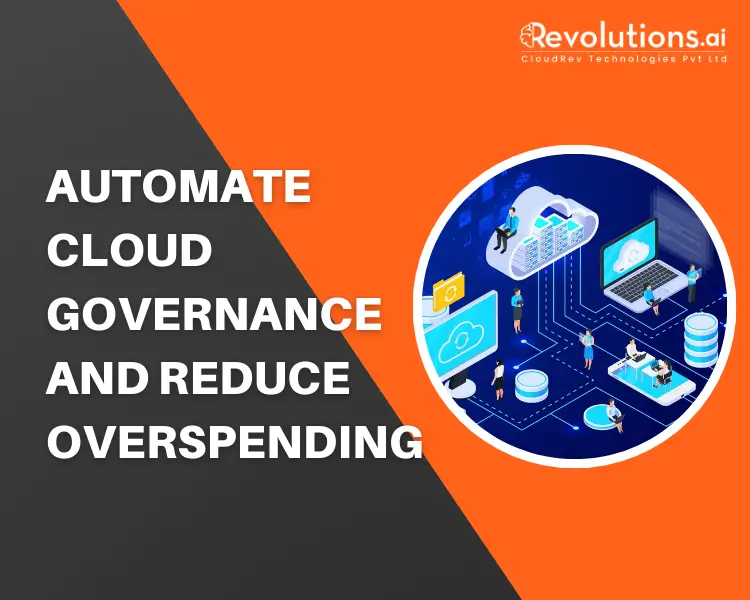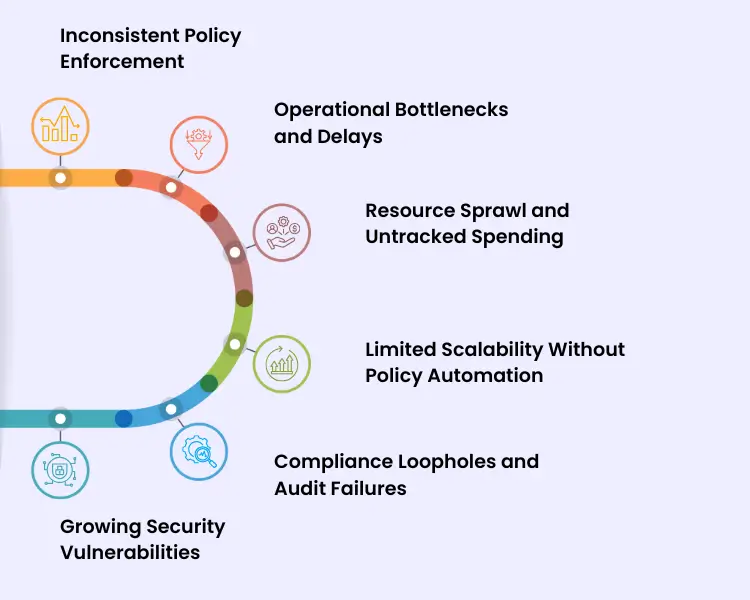Let’s face it—controlling cloud spend and having everything under wraps seems more like attempting to rein in a paper hurricane. One minute you think you have it all completely under control, and the next, your cloud bill goes through the roof out of nowhere. Ring any bells? That’s why to Automate cloud governance is more important than ever. It’s not only a matter of monitoring expenses, it’s about setting the proper guardrails upfront so your cloud journey does not become a money gut-wrenching free fall.
Today’s digital-first era has organizations growing fast, spinning up resources on multiple clouds, teams, and regions. But without the strong framework to track usage and enforce policies, it’s simple to lose visibility and control. It offers the framework to direct cloud operations aligned with business goals while keeping accountability and optimization intact at all levels.
This blog explores how automating can drastically reduce overspending and free up your team from manual checks and endless cost reviews. From defining usage policies to auto-remediating misconfigurations, you’ll discover practical steps and tools that bring consistency, visibility, and financial discipline into your cloud ecosystem—without slowing innovation down.
What is Cloud Governance in Modern IT Environments?
In the high-speed cloud environment of today is a strategic model that guarantees cloud resources are being monitored, managed, and optimized according to business objectives. With more and more organizations choosing multi-cloud and hybrid structures, governing the cloud environment is critical for gaining control, mitigating risks, and enhancing operational efficiency. It’s not merely a technical need, it’s a business necessity that extends across security, cost, performance, and adherence.
Today is a mixture of policies, processes, and tools to manage cloud usage without sacrificing agility. It means determining who should have access to certain resources, enforcing naming conventions, applying role-based access controls, and establishing automated guardrails that preclude policy breaches. Based on a well-designed governance model, companies can maintain consistency within teams, prevent misconfigurations, and eliminate wasteful expenditure due to over-provisioned or abandoned assets.
One of the primary elements of this strategy is cloud adherence, making sure cloud activities meet internal guidelines and external laws. This not only lightens the load for IT departments but also gives stakeholders transparency and assurance that the cloud platform is secure, helpful, and compliant with organizational mandates in general.
What are the Risks Of Manual Governance In Cloud Operations?
Drifting solely on manual means can put organizations at risk of a variety of inefficiencies, loopholes, and financial losses. When cloud environments grow exponentially, without automation, it is challenging to ensure consistency, standards enforcement, and real-time response. Without a formal governance model, manual controls frequently result in operational blind spots that may impact security, cost savings, and regulation adherence.
- Inconsistent Policy Enforcement
Manual management tends to create disjointed policy enforcement between departments and cloud accounts. Teams can adhere to different standards, naming conventions, or provisioning procedures, causing confusion and a greater likelihood of mistakes. Over time, it becomes difficult to maintain accountability and makes auditing processes more complex. - Resource Sprawl and Untracked Spending
Without automated tagging, tracking, and reporting capabilities, it is hard to keep track of who created what, when, and why. This tends to lead to orphaned or unused resources that balloon cloud bills. The lack of visibility makes cost optimization almost impossible and fuels uncontrolled overspending. - Growing Security Vulnerabilities
Manually updating access controls, permissions, and configurations raises the risk of misconfigurations and human mistakes. These security loopholes can provide the entry point for unauthorized access or data breaches, particularly with sensitive workloads. Remediation efforts typically come too late to avoid harm. - Adherence Loopholes and Audit Failures
Enforcing rules in an inconsistent or undocumented manner makes Adherence with regulatory and internal requirements challenging. Manual operations render it impossible to produce accurate audit trails, exposing organizations to non-adherence and possible legal consequences during regulatory audits. - Operational Bottlenecks and Delays
Manual management imposes high overhead on IT staff, who need to spend hours analyzing resource usage, making changes, and ensuring configurations. Such delays can put the brakes on innovation, as teams must await approvals or policy clarification before rolling out new workloads. - Limited Scalability Without Policy Automation
With the increasing use of cloud, manual governance management is unsustainable. Organizations find it difficult to keep up with mounting workloads, resulting in governance fatigue and failure to pick up critical updates. In contrast, automation provides scalable, systematic enforcement that adapts to changing business needs, providing long-term cost control and agility.
What Best Practices Help to Reduce Cloud Waste?
Cloud waste reduction starts with having complete insight into resource consumption throughout the organization. The right teams need to use accurate tagging rules from day one to categorize workloads by project, owner, and environment. This assists in detecting unused or idle resources such as unattached volumes, unused compute instances, and forgotten development environments that quietly burn budgets over time.
Rightsizing is another essential practice. Rather than provisioning resources on estimates or peak loads, tracking actual workload requirements allows for better sizing of compute, storage, and database instances. Periodic checks even ensure resources remain in line with performance requirements without over-allocation.
To further reinforce cost-helpfulness, organizations can implement cost controls in cloud environments by establishing budget alarms, imposing usage limits, and implementing auto-scaling policies. However, incorporating cloud cost dashboards and reports into operational processes makes financial responsibility a collective task. Through the confluence of automation and real-time insights, teams can cut waste and align cloud expenditures with business value.
What Governance Models Work Best for Large Enterprises?
Big organizations sometimes need a hybrid governance approach that combines centralized management with distributed control. What this really means is corporate IT establishes core policies, such as security policies, identity access, and adherence requirements—while specific teams or departments handle resources under those specifications. This type of model enables agility on the edge without sacrificing consistency.
A tiered governance structure is another successful approach. This framework classifies policies into required enterprise-wide guidelines, suggested best practices, and team-specific policies. It enforces important areas such as data privacy, encryption, and money tracking as absolute, without taking away the teams’ ability to innovate and roll out fast.
The success of such models depends on strict cloud policy enforcement. Policy engines can automatically detect and correct noncompliant configurations in real time, limiting the need for manual intervention. With enterprises growing across multi-cloud setups, having a governance model that includes automated enforcement guarantees consistency, security, and cost management—regardless of how sophisticated the infrastructure grows to be.
What’s the Difference Between Governance and Cloud Management?
Cloud management and governance are both critical elements of cloud operation, but for different purposes. It further involves determining the strategic policies, controls, and guardrails that establish how cloud resources ought to be used, protected, and monitored.
Cloud management, on the other hand, refers to the operational deployment—provisioning, optimization, and upkeep of cloud services on a daily basis. Governance makes the why and how decisions, while management makes sure those decisions are executed properly.
- Focus and Purpose: It establishes policies and regulations. Cloud management carries out activities such as resource allocation, monitoring, and performance tuning according to those policies.
- Strategic vs. Operational: AutomateCloud governance is strategic, making sure that cloud consumption complies with business, financial, and regulatory objectives. Management is operational, prioritizing efficiency and system health.
- Cloud Adherence and Risk Mitigation: Governance manages regulatory adherence, access controls, and security policies to reduce risk. Management ensures that those controls are enforced repeatedly throughout cloud infrastructure.
- Policy Design vs. Enforcement: Governance is about building the structure—who can do what, under what circumstances. Management is about enforcing and monitoring the efficacy of those choices.
- Toolsets and Automation: Governance tooling consists of policy engines, audit tools, and tagging standards. Management tooling concerns resource orchestration, cost monitoring, and workload performance.
- Long-Term vs. Day-to-Day Operations: Governance facilitates sustainable, long-term cloud strategy. Management provides for day-to-day operations to run continuously and respond to changes rapidly.
Conclusion
While cloud environments become more and more complex and decentralized, having robust, automated cloud governance is not a luxury anymore—it’s essential. Failing to have a strategic framework in position can mean spiraling expenses, security vulnerabilities, and regulatory issues. By actively establishing policies, enforcing them automatically, and having real-time visibility, companies can keep their cloud operations on track with performance targets and financial responsibility.
Revolution AI equips businesses with the ability to own their cloud environments through customized governance automation solutions. From spotting inefficiencies to choosing policy controls, we assist in developing a cloud infrastructure that is agile as well as sustainable. With an emphasis on optimization, we assist organizations to innovate with confidence, without sacrificing control.
Frequently Asked Questions
It is the collection of policies, procedures, and tools that are employed to guide cloud usage, maintain compliance, and manage costs. It's necessary to sustain visibility, prevent misconfigurations, and have cloud operations align with business objectives.
Automation enforces policies in real time, detects anomalies, controls resource use, and implements security protocols without human intervention. This eliminates human error and enforces consistent governance across teams and environments.
The most popular tools are AWS Config, Azure Policy, Google Cloud's Organization Policy Service, and third-party platforms such as CloudHealth, Terraform, and Dome9. These tools offer policy-as-code, automated notifications, and compliance monitoring.
Organizations can identify and eliminate cloud waste through the use of tagging standards, monitoring unused or underutilized resources, rightsizing instances, and scheduling non-essential workloads.

Hemal Sehgal
Introducing Hemal Sehgal, a talented and accomplished author with a passion for content writing and a specialization in the blockchain industry. With over two years of experience, Hemal Sehgal has established a strong foothold in the writing world, c...read more




